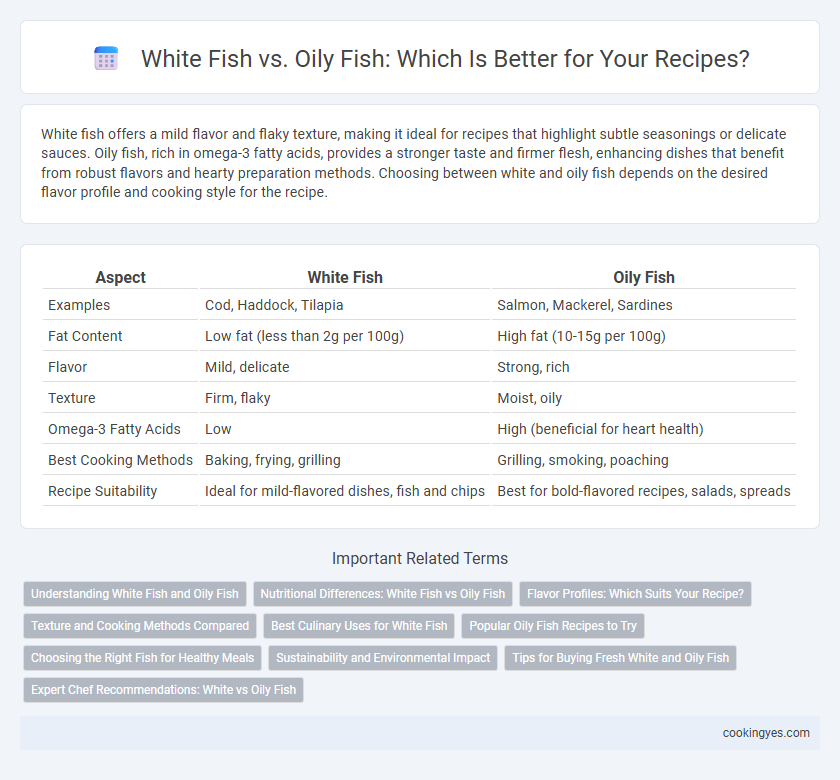White fish offers a mild flavor and flaky texture, making it ideal for recipes that highlight subtle seasonings or delicate sauces. Oily fish, rich in omega-3 fatty acids, provides a stronger taste and firmer flesh, enhancing dishes that benefit from robust flavors and hearty preparation methods. Choosing between white and oily fish depends on the desired flavor profile and cooking style for the recipe.
Table of Comparison
| Aspect | White Fish | Oily Fish |
|---|---|---|
| Examples | Cod, Haddock, Tilapia | Salmon, Mackerel, Sardines |
| Fat Content | Low fat (less than 2g per 100g) | High fat (10-15g per 100g) |
| Flavor | Mild, delicate | Strong, rich |
| Texture | Firm, flaky | Moist, oily |
| Omega-3 Fatty Acids | Low | High (beneficial for heart health) |
| Best Cooking Methods | Baking, frying, grilling | Grilling, smoking, poaching |
| Recipe Suitability | Ideal for mild-flavored dishes, fish and chips | Best for bold-flavored recipes, salads, spreads |
Understanding White Fish and Oily Fish
White fish, such as cod, haddock, and pollock, features a mild flavor and flaky texture, making it ideal for baking, frying, or poaching in delicate recipes. Oily fish like salmon, mackerel, and sardines contain higher fat content and rich omega-3 fatty acids, offering a stronger taste and firmer texture suitable for grilling, smoking, or broiling. Choosing between white and oily fish depends on desired flavor intensity, cooking method, and nutritional needs.
Nutritional Differences: White Fish vs Oily Fish
White fish like cod and haddock contain lower fat levels and are rich in lean protein, making them ideal for low-calorie recipes. Oily fish such as salmon and mackerel provide high amounts of omega-3 fatty acids and vitamin D, supporting heart and brain health. Choosing between white and oily fish depends on desired nutritional benefits, with white fish preferred for protein-focused dishes and oily fish favored for essential fatty acid intake.
Flavor Profiles: Which Suits Your Recipe?
White fish, such as cod and haddock, features a mild, delicate flavor and flaky texture, making it ideal for recipes where subtlety allows other ingredients to shine. Oily fish like salmon and mackerel offers a rich, robust taste and firmer flesh, perfect for dishes requiring a bold, pronounced flavor profile. Selecting between white and oily fish depends on whether the recipe calls for a light, versatile base or a hearty, flavorful element.
Texture and Cooking Methods Compared
White fish, such as cod and haddock, have a mild flavor and flaky, delicate texture ideal for baking, frying, or poaching. Oily fish like salmon and mackerel possess a richer taste and firmer, meatier texture, making them well-suited for grilling, smoking, or roasting. Choosing between white and oily fish depends on desired texture and cooking method compatibility, with white fish absorbing flavors quickly and oily fish retaining moisture longer.
Best Culinary Uses for White Fish
White fish, such as cod, haddock, and sole, are prized for their mild flavor and flaky texture, making them ideal for recipes requiring delicate seasoning and gentle cooking methods like poaching and baking. Their low oil content allows them to absorb spices and marinades effectively, perfect for dishes like fish pies, fish tacos, or light fish stews. White fish also crisp beautifully when fried or grilled, offering versatility in both simple and elaborate culinary creations.
Popular Oily Fish Recipes to Try
Popular oily fish recipes to try include grilled salmon with lemon and dill, mackerel pate, and spicy sardine pasta, each offering rich omega-3 fatty acids and robust flavors. Unlike white fish, oily fish such as salmon, mackerel, sardines, and trout have higher fat content, making them ideal for recipes that benefit from moist, flavorful textures. These recipes emphasize heart-healthy benefits while delivering bold tastes that enhance a variety of culinary dishes.
Choosing the Right Fish for Healthy Meals
White fish such as cod, haddock, and tilapia are low in fat and have a mild flavor, making them ideal for light, delicate recipes that require quick cooking methods like grilling or baking. Oily fish like salmon, mackerel, and sardines are rich in omega-3 fatty acids, supporting heart health and adding a robust taste suitable for richer dishes or smoking. Selecting white fish offers lean protein benefits with less fat, while oily fish provides essential nutrients and a distinctive flavor, allowing for versatile meal options that align with specific health goals.
Sustainability and Environmental Impact
White fish such as cod and haddock generally have a lower environmental impact compared to oily fish like salmon and mackerel due to their faster growth rates and more efficient feed conversion ratios. Sustainable fishing practices prioritize species with abundant populations and minimal bycatch, often favoring white fish harvested from well-managed fisheries. Choosing white fish from certified sustainable sources helps reduce overfishing risks and supports marine biodiversity, making them a more environmentally friendly option for recipes.
Tips for Buying Fresh White and Oily Fish
Choose white fish like cod, haddock, or sole for mild flavors and flaky textures, ideal for baking or frying recipes. When buying fresh oily fish such as salmon, mackerel, or sardines, look for shiny, firm skin and a fresh sea aroma indicating high omega-3 content and good quality. Avoid fish with dull eyes or a fishy smell to ensure freshness and optimal taste in your dishes.
Expert Chef Recommendations: White vs Oily Fish
Expert chefs recommend choosing white fish like cod, haddock, or sole for recipes requiring a mild flavor and firm texture, ideal for frying, baking, or poaching. Oily fish such as salmon, mackerel, and sardines are preferred in dishes where richness and omega-3 fatty acids enhance flavor and nutrition, often grilled or smoked. Understanding the fat content and cooking method helps optimize the dish's taste and health benefits, aligning ingredient selection with culinary goals.
White fish vs oily fish for recipe choice Infographic

 cookingyes.com
cookingyes.com